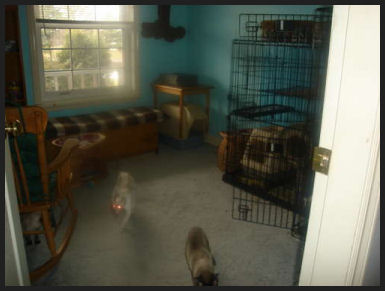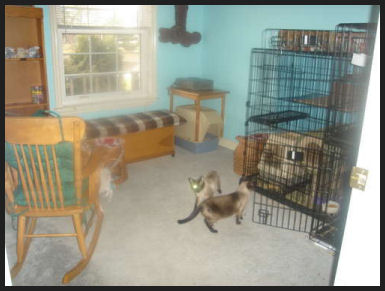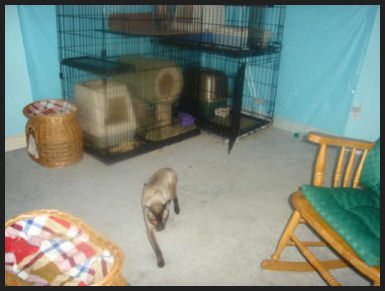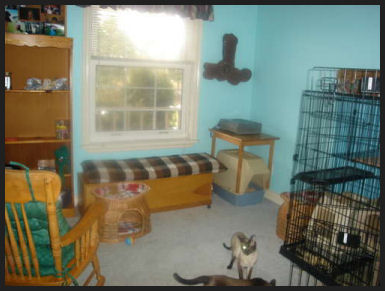
CCA, CFA and TICA Registered
*Contact for available color points
Home Page | Labrador Retrievers | Tips of the Month | Brittany Spaniels | Maltese | Articles
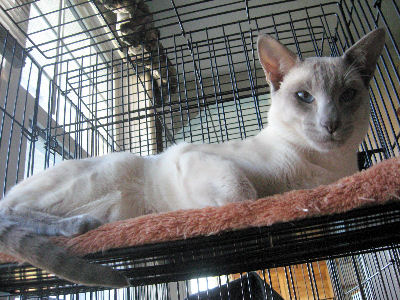
"Zodiac", King of the Cattery!
Meet Miss Lilly
Daughter to Summit Mews Lavender Rein "Missy"
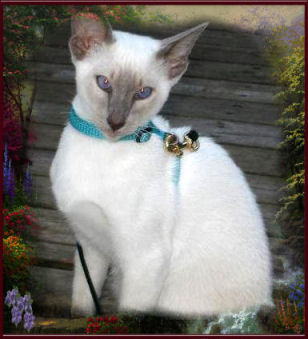
This beautiful kitten was from "Missy's" litter 07/07/07. Meet SIAM RITCHIE! Siam has photos in the web albums also.
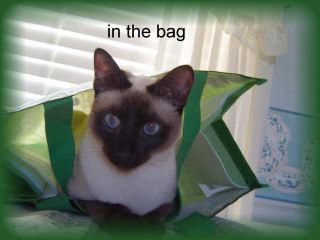
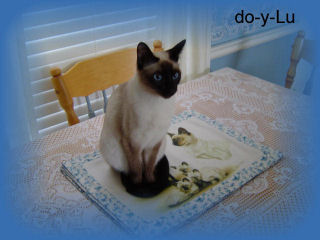
Do-Y-Lu Smith

Station One Reg'd Cattery is located in beautiful Sussex, NB
Home of Quality Siamese Companions
Station One Reg'd Cattery guarantees the health of our kittens with a written 2 year guarantee. Kittens are vet checked and vaccinated before going to their new homes. We offer after sales support to all our clients. Color points bred are seal, chocolate, blue and lilac. Lynx point (Color point shorthair) are available in the same color points. Occasionally we have adult cats retiring.


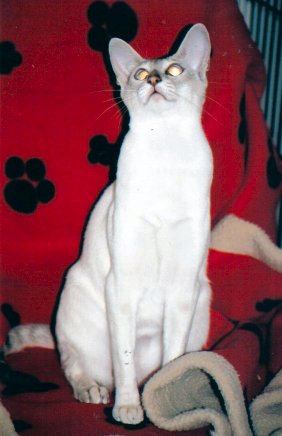 The Siamese, famed for combining the grace of a panther, the fleetness of a deer, the softness of down, strength of a lion, and the affection of a dog, is one of the oldest recognized cat breeds.
The Siamese, famed for combining the grace of a panther, the fleetness of a deer, the softness of down, strength of a lion, and the affection of a dog, is one of the oldest recognized cat breeds.
It's origins are lost in the mists of time, but there is evidence that Siamese were well-known in Ayutthaya, (ancient capitol of Siam), founded in 1350. It is some 120 years since the breed was introduced to the Western World.
This captivating creature has become a firm favorite world-wide. The breed has been developed and there are now many different colors of Siamese available.
Top
Summit Mews Lavender Rein "Missy" ------------------------------------->

In 1884, Owen Gould brought to England a pair of Siamese cats from Siam as a gift for his sister Lillian. These two cats, Pho and Mia, father and mother, are 1a and 2a in the British Siamese Cat Register, but they have no "pedigree", their particulars are "unknown, imported from Bangkok". The progeny of Pho and Mia, Duen Ngai and Kalahom and Karomata, were exhibited at the Crystal Palace in 1885 and excelled all competitors, but unfortunately died after the show.
Between 1884 and the end of the century, a considerable number of Siamese cats were imported into England and are recorded in the British Siamese Cat Registers. Miss Forestier Walker, one of the founder members of the original Siamese Cat Club in England, owned Tiam O'Shian, an ancestor of Tiam O'Shian IV, who was a prizewinner at the the London Crystal Palace Shows of 1900 and 1901.
Mrs. Robert Locke founded the Beresford Cat Club in 1899 and was its first president. Mrs. Locke owned the first registered Siamese cats in America, Lockhaven Siam and Sally. Calif and Bangkok were bred from Siam and Sally Ward. It was said that Calif and Siam "carried all before them" at the Chicago show in 1902.
Probably the first Siamese cat in America arrived during the presidency of Rutherford B. Hayes (1877-1881) as a gift from the American consul in Bangkok to the President's wife, Mrs. Lucy Webb Hayes. Mrs. Hayes was notified that a Siamese cat consigned to her had arrived from Hong Kong on January 3, 1879. It was transported to San Francisco on the steam-powered SS Belgic, with charges prepaid by the consul in Bangkok. The cat had been placed in the charge of the ship's purser until San Francisco and thence was sent by express to Washington. After the cat's safe arrival at the White House, she was named Siam, and soon became a much-admired favorite. Many legends surround the Siamese cat, and there is one particularly endearing myth which associates the creation of the Siamese with the journey of Noah's Ark.
In a story from a book entitled Animals and Man, by George Cansdale, a description was given of the boredom of the animals in the Ark during their long journey, and of their ways of alleviating it. The Siamese, it says, originated through interspecies mating, with the ape falling in love with the lioness who then produced the first cat. This type of mating leaves much to imagination but, so the story goes, it gave birth to the character of the Siamese, which is said to have the "attributes of an ape and the bravery of the lion".
The Siamese cat originated from Thailand, formerly known as Siam. These cats were held in such high esteem in their native country that no one except the King and members of the royal family were permitted to own them. They were originally known as Royal points.
Written records reveal that Siamese cats, in their country of origin, were venerated as guardians of the temples. When a person of high rank died, it was usual to select one of these cats to receive the dead person's soul. The cat was then removed from the royal household and sent to one of the temples to spend the rest of its days living a ceremonial life of great luxury, with monks and priests as its servants. These cats were reputed to eat the finest foods from gold plate and to recline on cushions made of the most opulent materials, which had been provided by the departed one's relatives in an attempt to receive good fortune and blessings. Once they became temple cats, they were supposed to have special powers and could intercede for the soul of the dead person.
Years ago features such as crossed eyes and kinked tail were looked on as characteristics of the breed and many legends exist as to their origin.
It was said that a Princess of the Royal House of Siam used her cat's tail as a ring-stand while she was bathing. The kink in the tail prevented the rings from falling off and being lost.
Another legend accounts for both the cross-eyed feature as well as the development of the kink. Once, when all the men of Siam left their homes to defend their kingdom, just two cats - one male Siamese, Tien, and one female Siamese, Chula - remained in order to guard Buddha's golden goblet in the sacred temple. The male cat became pretty restless and, after mating the female Siamese, left her in order to find another priest to look after the temple. The female, apparently, was so overwhelmed by the responsibility of guarding the Buddha's treasure that she never once glanced away from the goblet, wrapping her long tail around its stem to prevent theft in case she should fall asleep. As time passed waiting for Tien to return with a new master, she could no longer forstall the birth of her kittens, who all arrived with the physical characteristics that she herself had acquired during her period as watchguard - a kinked tail and crossed eyes. Just occasionally, even today, kittens are born with these features - so the legends are kept alive.
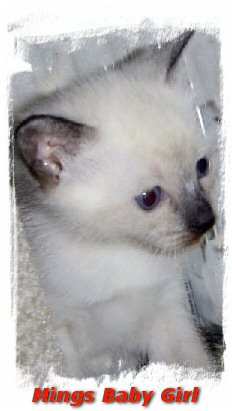
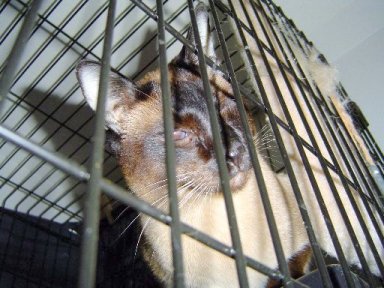
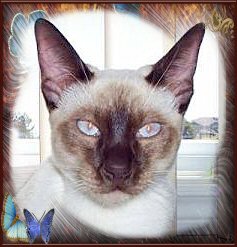 Siamese cats are typically born white. Apparently the genetics of our coloring is that we are partially albino. There is a mutation in one of our genes involved in melatonin production. This gene is heat sensitive. It doesn't work at body temperature but it does work on color parts of the body. As Siamese cats age, the points start darkening. Points are usually the face, ears, paws and tail--all parts that tend to cold easier.
"Colourpoints" have non-traditional, but recognized colour points. These points include Lynx Points (light gray striped points), Flame or Red Points (orange colour points), Cream Points (a light version of the Red Point) and Torti Points (orange, white and black colour points).
Siamese cats are typically born white. Apparently the genetics of our coloring is that we are partially albino. There is a mutation in one of our genes involved in melatonin production. This gene is heat sensitive. It doesn't work at body temperature but it does work on color parts of the body. As Siamese cats age, the points start darkening. Points are usually the face, ears, paws and tail--all parts that tend to cold easier.
"Colourpoints" have non-traditional, but recognized colour points. These points include Lynx Points (light gray striped points), Flame or Red Points (orange colour points), Cream Points (a light version of the Red Point) and Torti Points (orange, white and black colour points).

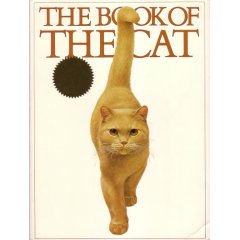


 kittycatbreeders.com
kittycatbreeders.com